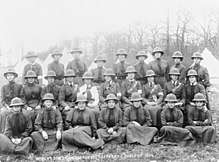Alice Hutchison
Alice Hutchison was a British doctor who served in the Balkan and First World Wars. She was one of the first women to lead a war-time hospital unit.
Alice Hutchison | |
|---|---|
 | |
| Died | 1953 |
| Nationality | British |
| Other names | Hutchinson (different spelling) |
| Occupation | Doctor |
Early life and education
Alice Marion Hutchison was born 12 August 1874 in Dalhousie, India. Her father, John Hutchison, was a missionary working in India for the Church of Scotland; her mother was Margaret Andrew.[1][2][3] She was educated at Beechwood in Moffat[4], and in Bridge of Allan.[1]
Career

She became a doctor after graduating from the University of Edinburgh in 1903. Afterwards, she was the doctor in charge of the John Street Dispensary in Edinburgh, a hospital that provided free medical care. She was in India, serving during a cholera epidemic that hit the country. [5]
Hutchison was one of the three women doctors who travelled to Bulgaria as part of the Women's Sick and Wounded Convoy Corps. The Corps, which was set-up by Mabel St Clair Stobart, was almost all women, with the exception of three men. The unit spent five weeks in the country treating the wounded and sick as a result of the war. They left after the armistice was signed.[6][7]:62
World War I
She volunteered at the outbreak of World War I for the Scottish Women's Hospitals for Foreign Service (SWH). She was the first doctor from the SWH sent to France and was initially placed in Boulogne, France. While looking for a building to house a hospital, a typhoid epidemic broke out amongst Belgian refugees in Calais. She, along with another doctor and ten nurses, treated the patients. She was noted for having the lowest rate of deaths due to typhoid in her hospital.[8][9][10]
In May 1915, she and her unit, named the London-Wales Unit, were sent to Serbia. On their way there, they stopped in British controlled Malta. They were detained by the British military and ordered to treat the wounded there. This was the only time in the war where SWH officially treated British wounded.[11] :1060
After two weeks in Malta, they arrived in Serbia to set up 40-tent hospital in Valjevo.[12]:239-240[13] In October, an invasion of German and Austro-Hungarian forces entered Serbia, pushing back the army. After Bulgaria invaded, the Serbian military decided to retreat through Albania. Hutchinson decided to not follow the Serbian army but stayed with her patients. She was captured by Austro-Hungarian forces on 15 November 1915. She, along with members of her unit, spent three months interned in Hungary. She successfully argued for their release, citing the Geneva Convention. In February 1916, they were sent across the border to Switzerland, arriving back in England on 12 February.[12] Following her return from Serbia, she was awarded the Order of St. Sava (third grade) for running one of the units which cared for the wounded Serbian soldiers.[14]
Later life
She moved to London, England after the war, where she worked in several hospitals. She died at the age of 79 in 1953.[5]
References
- Hutchison, Alice Marion (1953-11-07). "OBITUARY". British Medical Journal. 2 (4844): 1050–1052. doi:10.1136/bmj.2.4844.1050-b. ISSN 0007-1447. PMC 2029985. PMID 13094114.
- Hutchison, John (1936-08-08). "Obituary". The Times (47448). p. 12. Retrieved 2018-11-06 – via GALE Group.
- Hutcheson, Alice Marion. "India Births and Baptisms, 1786-1947". FamilySearch. Retrieved 2018-11-06.
- "Moffat Lady in Serbia Safe". Daily Record and Mail (21470). 1915-11-11. p. 3. Retrieved 2018-11-06 – via British Newspaper Archive.
- McEwen, Yvonne. "10 Scottish Women's Hospital Women" (PDF).
- "The Women's Sick and Wounded Convoy Corps at the Balkan War". Kai Tiaki : The Journal of the Nurses of New Zealand. VII (2): 29. 1914-04-01.
- Stobart, Mabel Annie Boulton (1913). War and women, from experience in the Balkans and elsewhere. London, G. Bell & Sons, Ltd.
- "Indianapolis Medical Journal". 1915. Cite journal requires
|journal=(help) - Shrady, George Frederick; Stedman, Thomas Lathrop (1918). "Medical Record". W. Wood. Cite journal requires
|journal=(help) - Leneman, L (April 1994). "Medical women at war, 1914-1918". Medical History. 38 (2): 160–177. doi:10.1017/s0025727300059081. PMC 1036842. PMID 8007751.
- The Encyclopaedia Britannica: A Dictionary of Arts, Sciences, Literature and General Information. Encyclopaedia Britannica. 1922.
- Drinker, Frederick E. (1917). Our War for Human Rights: Being an Intensely Human and Brilliant Account of the World War and why and for what Purpose America and the Allies are Fighting, Including the Horrors and Wonders of Modern Warfare, the New and Strange Devices that Have Come Into Use, Etc. ... Austin Jenkins.
- "Women And The First World War: The Work Of Women Doctors". Woman and her Sphere. 2014-05-06. Retrieved 2018-04-20.
- "Serbian Decorations for Scottish Women". Dundee Evening Telegraph (12287). 1916-04-14. p. 1. Retrieved 2018-11-06 – via British Newspaper Archive.